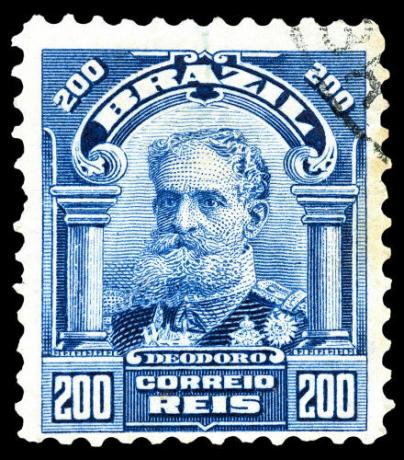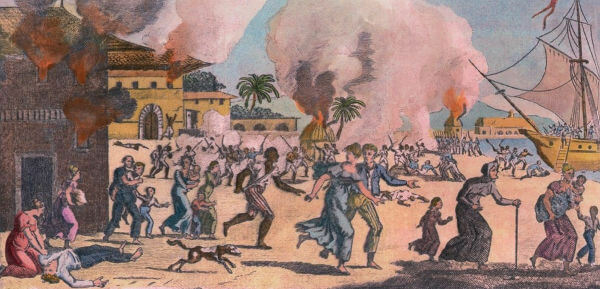O brazilwood is very well known, because its exploration was the first economic activity exercised by the Portuguese in Portuguese America during the 16th century. The exploration of pau-brasil was very intense, especially in a phase known as Precolonial Period, which lasted until the mid 1530s. The exploitation of wood took place through bartering with the indigenous people.
Features
The brazilwood is a tree typicalgivesAtlantic forest (paubrasilia echinata) and that in the 16th century it was known by the Tupi Indians of ibirapitanga. It is a tree that can reach up to 15 meters and has thorny branches.
The tree gained importance to the Portuguese because of its wood, which could be used in the constructionincountlessobjects (such as furniture and boxes), but mainly because the resin from the wood was used to produce dye used for dyefabrics.
Historians point out that in medieval Europe a tree similar to brazilwood was already known. This one, however, was originally from Asia, and is known as
Biancaea Sappan. The records point out that the wood it's the dye of this tree were known by names like “brecilis” and “brezil”. This dye was used to dye fabrics in Europe, and this name circulated in various parts of the continent, as early as the 12th and 13th centuries.
The strong reddish tone extracted from the resin present in pau-brasil was used to dye fabrics in Europe.
With the arrival of the Portuguese in Brazil, the tree was seen as a potential commodity to be resold in Europe and, thus, its exploration was soon started. The first person who received the right to explore pau-brasil, according to historians Lilia Schwarcz and Heloísa Starling, was Ferdinand of Loronha, in 1501|1|.
Fernão de Loronha (or Noronha) won the right to explore the territory, in 1501, and, soon after, received the São João island (current Fernando de Noronha) as captaincy. Fernão de Loronha, then, obtained the right to explore pau-brasil and, for this reason, was prohibited from importing the Asian variety of the Brazilian tree.
In 1511, the first export of brazilwood to Portugal took place, when 5 thousand tree logs were taken to Portugal on the ship called Bretoa|2|. In that same year, the lease given to Fernão de Loronha ended and was transferred to Jorge Lopes Bixorda, and, from 1513 onwards, anyone interested in exploring pau-brasil could do so, as long as they paid the taxes owed to the Crown. (20%).
Do not stop now... There's more after the advertising ;)
Name origin
The name of pau-brasil is the target of a lot of speculation it's from debate among historians. The consensus currently is that the term "Brazil" referred to the resin found in wood that has a reddish tone. Historians Lilia Schwarcz and Heloísa Starling suggest that the term “Brazil” and all its variations come from the Latin term “brasilia”, which meant “ember color” or “red”|3|.
Over time, the name used to refer to wood and dye was used to name the new land. This happened from 1512, when the merchandise arrived on the European market. The nomenclature of Portuguese America was something that varied a lot during the first years of the Portuguese presence.
Portuguese America was called by several names such as Vera Cruz Island, Tmiss of the parrots, land of Santa Cruz and Brazil, for example. The issue of the name of Brazil generated some controversy, as some Portuguese did not accept the replacement of the name as Pero Magalhães de Gandavo.
This chronicler published, in 1576, a book called “History of the Province of Santa Cruz”, in which he reported several things referring to Portuguese America and in a certain part of his report he defended the return of the name “Terra de Santa Cruz” for reasons religious.
Another important issue regarding the nomenclature of pau-brasil is that, even in Tupi, the name used by the natives to refer to the tree mentioned the color present in the wood. The term "ibirapitanga" means "red tree”.
Historical context
The exploration of pau-brasil, during the 16th century, was inserted in the context of arrival of the Portuguese in America. The arrival of the Portuguese in Brazil was in April 22, 1500, when Pedro Álvares Cabral's expedition sighted Monte Pascoal, in the current region of Porto Seguro, in the state of Bahia.
The arrival of the Portuguese in Brazil started the process of explorationof thelands. This process only became a colonizing process in the 1530s, when the system of hereditary captaincies. Before the implementation of the captaincy system, the presence of the Portuguese was exclusively on the coast through trading posts.
How was the exploration of pau-brasil carried out?
The exploration of pau-brasil by the Portuguese was accompanied by trading posts built by the Portuguese in coastal locations in Portuguese America. The main factories built by the Portuguese, in this first moment of their presence in America, were the factories located in the CableCold, HarborSafe and Igarassu (Pernambuco).
The Portuguese factories were basically places where the Portuguese stored all the extracted wood. The trading posts were surrounded by a wooden palisade that protected them from possible attacks by hostile indigenous peoples and foreigners who, in this case, were the french the big ones competitors of the Portuguese in the exploration of pau-brasil.
The functioning of the trading posts, in large part, was the result of the registration made during the arrival of the vessel Bretoa, which was in Portuguese America, in 1511, as mentioned above. In these factories, the Portuguese hired the work of the indigenous people so that they could carry out the work of felling the trees.
This is because the redwood trees were not huddled next to each other, but were scattered throughout the forest and, thus, the knowledge of the territory by the indigenous people made it possible for them to locate the trees with the most ease. The working relationship was for the barter. The Indians extracted and took the logs to the factories, and the Portuguese repaid them with knives, pocketknives, mirrors and other similar objects.
The necessity of constructionof thetrading posts was explained by historian Jorge Couto, who stated that the factories were built, because in Gonçalo Coelho's expedition along the Brazilian coast, in 1501-1502, the The Portuguese realized that the work of extracting wood while the ships were anchored on the Brazilian coast was very expensive and, therefore, it was proposed to build factories that storethe wood extracted so that, from time to time, a ship could come and collect the logs|4|.
Good relations with the indigenous peoples were an essential condition for the success of the factory, since it was through their work that the extraction of wood was carried out. The fortification of the factory or its construction close to a fort was also essential, as it guaranteed the safety of this factory.
This is because, in addition to hostile indigenous peoples, the Portuguese dealt with the french that, in the first years of the 16th century, invaded Portuguese lands (according to the Treaty of Tordesillas) to negotiate with the indigenous people and to smugglebrazilwood for the Europe. An example was the expedition of Paulmier de Gonneville who came here in 1503 to try to explore Brazil wood.
the crescent presencefrench on the Brazilian coast forced Portugal to invest in the development of expeditions whose function was to monitor the Brazilian coast. These expeditions, if they saw French vessels, were authorized to open fire. The French even tried to establish themselves in Brazil, first in Rio de Janeiro and later in Maranhão.
consequences of exploration

The intense exploitation of pau-brasil almost led the tree to extinction and, even today, it is considered an endangered species.
The exploration of pau-brasil was the means by which the Portuguese settled in Brazil. Through it, they installed factories and forts on the Brazilian coast and established relationsfriendly with certain indigenous peoples.
This activity, however, happened in such an intense proportion that it was responsible for the almostextinctionofbrazilwood, as millions of trees were felled. Timber extraction continued until the middle of the 19th century, and the recovery of the amount of trees in nature only took place in the second half of the 20th century.
|1| SCHWARCZ, Lilia Moritz and STARLING, Heloisa Murgel. Brazil: a biography. São Paulo: Companhia das Letras, 2015, p. 32.
|2| Idem, p. 32.
|3| Idem, p. 32.
|4| COUTO, Jorge. The genesis of Brazil. In.: MOTA, Carlos Guilherme (org.). Incomplete trip: The Brazilian experience. São Paulo: Editora Senac, 1999, p. 57-58.
*Image credits: commons
By Daniel Neves
Graduated in History


